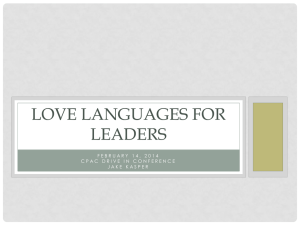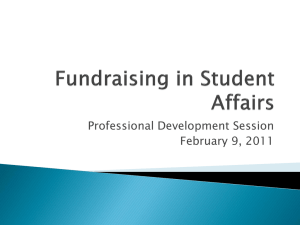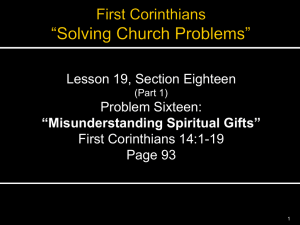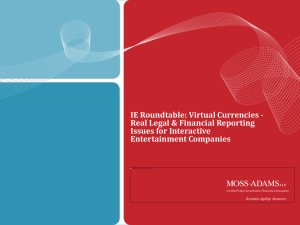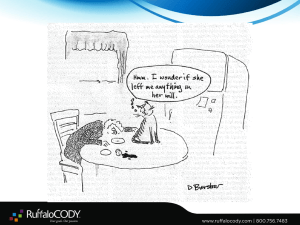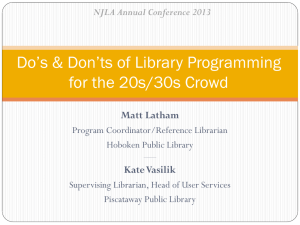Why measure? - Northwestern University
advertisement
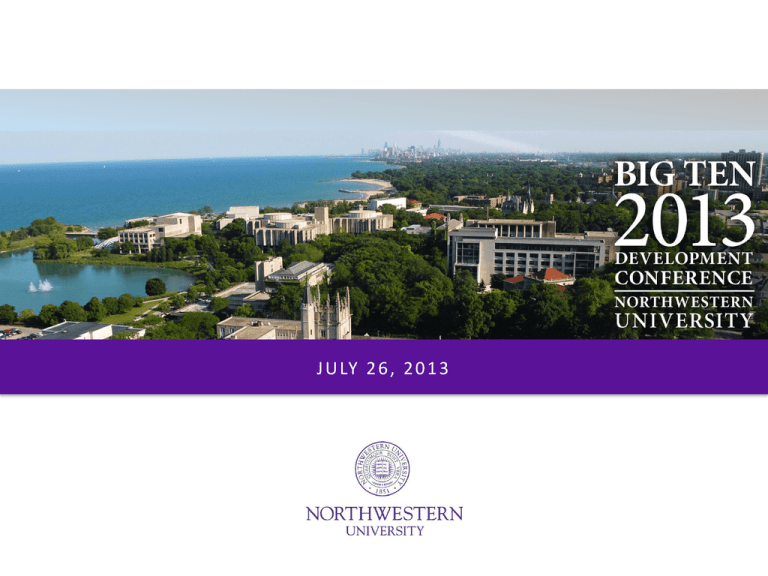
J U LY 2 6 , 2 0 1 3 Measuring Major Gift Officer Performance: A Case Study and Lessons Learned by Matt TerMolen and David Lively On Metrics… why measure? What gets measured gets done What gets measured and fed back gets done well What gets rewarded gets repeated Why Measure? Transparency inside the institution ROI (within Advancement team but also with budget) Best practices Helps to define success for fundraisers Clarifies success for upward advancement within the organization First: Fundraising is Expensive Major Gift Fundraiser Expenses: Salary Benefits (~28% of salary) Budget (travel, entertainment, etc.) Supplies (computer, phone, letterhead, etc.) Research (% of prospect research/mgmt. staff, etc.) Database (% of license/staff support, etc.) Space (office space, etc.) Other misc. expenses Training (CASE, etc.) Opportunity Costs (i.e. how else could $ be used?) Total Expenses: $________ $________ $________ $________ $________ $________ $________ $________ $________ $________ $________ What to Measure The Primary Goal: Raise more gifts now We will measure relevant major gift fundraiser activities that directly relate to soliciting and booking new major gift commitments. These activities include (but are not limited to): Number of new commitments Number of solicitations Dollars raised in new commitments What to Measure A Secondary Goal: Identify/Qualify New Prospects We will measure activities that directly relate to identifying, qualifying, and cultivating new major gift prospects, who will be solicited in future fiscal years. (Build the pipeline for the future.) These activities include (but are not limited to): Qualification calls (Face-to-face) Visits What to Measure Collaboration Encourage fundraisers to collaborate on solicitations. These activities include (but are not limited to): Proposal/solicitation assists Joint calls Shared strategies/multiple solicitations Implementing high-touch engagement across campus (e.g. reunion chairs, visiting committees, etc.) Case Studies DePaul University Northwestern University Case study: DePaul University AWARENESS: Generating awareness of the need for change The current system is not working MOBILIZATION: Enlisting resources and stakeholders to undertake change Identification of best practices: – Georgetown U./Oregon State U.: “The Placemat” – U. of Washington: “Top 25” Buy-in from Advancement leadership PILOTING: Preliminary testing of new possibilities Pilot run with business school for six months; full implementation 7/1/06 FULL SCALE IMPLEMENTATION: Adopting fundamental, far-reaching reform Implementation of Accountabilities Grid Implementation of Top 20/Next 50 portfolio system FY2007-2011 results DePaul University: “The Grid” FY2007 MINIMUM GOALS (minimums per category) SVP/VP/ AVP SENIOR DIRECTOR DIRECTOR ASSOC. DIRECTOR ASST. DIRECTOR Number of Contacts/Moves 80 180 180 240 240 Number of Face-to-Face Contacts/Moves 45 100 100 140 140 Number of Solicitations (of $25K+) 12 20 20 20 20 Number of Major Gifts Raised (of $25K+) 6 8 8 8 8 $ 4 million+ $ 2 million+ $ 750,000+ $ 500,000+ $ 250,000+ Major Gift Dollars Raised (pledges/gifts of $25K+) Major Gift Metrics & Accountability DePaul University Major Gift Summary: FY1989 - FY2011 Number of Gifts and Pledges of $25K+ 200 180 184 July 2006: Full Implementation of new goals & accountabilities system 160 162 150 140 139 120 118 100 73 60 59 40 90 89 80 42 67 65 56 56 48 82 53 44 50 49 48 40 36 20 0 FY2011 FY2010 FY2009 FY2008 FY2007 FY2006 FY2005 FY2004 FY2003 FY2002 FY2001 FY2000 FY1999 FY1998 FY1997 FY1996 FY1995 FY1994 FY1993 FY1992 FY1991 FY1990 FY1989 DePaul University Major Gift Summary: FY1989 - FY2011 Gift/Pledge Dollars of $25K+ $50,000,000 $45,000,000 July 2006: Full Implementation of new goals & accountabilities system $40,000,000 $35,000,000 $30,000,000 $25,000,000 $20,000,000 $15,000,000 $10,000,000 $5,000,000 FY2011 FY2010 FY2009 FY2008 FY2007 FY2006 FY2005 FY2004 Major Gift Metrics & Accountability FY2003 FY2002 FY2001 FY2000 FY1999 FY1998 FY1997 FY1996 FY1995 FY1994 FY1993 FY1992 FY1991 FY1990 FY1989 $- Case Study: Northwestern Current Status: Solid Major Gift activity in pre-Campaign Steady growth in recent years (but perhaps not significant enough to achieve projected campaign goals) Large pool of rated/evaluated prospects (unassigned) Campaign Needs: Need to significantly increase major gift outcomes in campaign Influx of new fundraisers Increase productivity of current fundraisers (i.e. increase rate of solicitation and volume of gifts) High number of unqualified but rated prospects in discovery Case Study: Northwestern Needed changes to improve fundraising productivity during campaign planning stages: Need 50%+ Increase in gifts of $100K+ Need 65%+ increase in gifts of $1M+ Grow annual fundraising totals from ~$220M to ~$400M during campaign Case Study: Northwestern Number of Major Commitments of $100K+ 450 Projections 400 Historical Giving Data 350 375 300 250 200 400 309 296 251 400 250 247 241 150 100 50 0 2007 2008 2009 2010 2011 2012 2013 2014 2015 Cumulative Major Gift Totals Per Month 350 309 300 276 250 200 150 100 50 0 AVG: FY06-FY10 FY11 FY12 FY13 (as of 6-27-13) Cumulative Major Gift $ Totals by Month $400,000,000 $350,000,000 $300,000,000 $250,000,000 $200,000,000 $150,000,000 $100,000,000 $50,000,000 $- AVG: FY06-FY10 FY11 FY12 FY13 (as of 6-27-13) The NU Accountabilities Grid Regional Director Director of Senior Associate Assistant of Major Gifts / Development / Associate Director of Director of Senior Director Director of Major Director of Development Development of Development Gifts Development AVP Executive Director of Development YES YES YES NO YES NO NO NO NO Number of Major Commitments ($100K+) 5 5 5 7 5 6 7 5 2 Number of Solicitations ($100K+) 9 9 10 14 11 14 16 12 6 $7M $5M $3.5M $4M $1.5M $1M $500K Visits (face-to-face) 30 40 80 90 80 90 100 115 130 Qualification Visits (Subset of Overall Visits) 15 20 20 30 25 30 40 50 75 Position Management Responsibilities Dollars Raised (Commitments of $100K+) $2.5M $3M The Scorecard TENTATIVE FY13 Score Card Number of Number of Dollars Number of Major Solicitations Raised Qualifications Commitments Visits TOTALS 200% or more of Goal 39 38 30 15 12 133 175-199% of Goal 36 35 26 14 11 122 150-174% of Goal 33 32 24 13 10 112 125-149% of Goal 30 29 22 12 9 102 101-124% of Goal 27 26 20 11 8 92 100% (Achieve Goal) 25 24 18 10 7 84 75-99% of Goal 23 22 16 9 6 76 50-74% of Goal 20 19 14 8 5 66 25-49% of Goal 17 16 12 7 4 56 1-24% of Goal 14 13 10 6 3 46 0% (No Activity) 0 0 0 0 0 0 Secondary Solicitations (Proposal Assists) >10 asks 8-9 asks 6-7 asks 3-5 asks 1-2 asks No Activity TOTALS 10 7 5 3 2 0 Lessons Learned: what’s working, what isn’t? Lessons Learned: The system should constantly be improved as more data are available (goals that are too high create anxiety, goals too low don’t motivate) Metrics improved morale as all fundraisers understood the goals and the roadmap to success By making the focus on asks/gifts we became more purposeful in our work and in timemanagement Improved tools for managers as everyone understood the system, which is transparent and consistent across all teams What is working at NU? Great buy-in from across all teams Agreement from all fundraisers and managers that we can and should increase our activity We created a system that helps focus fundraisers on closing gifts 20 percent increase in $100K+ commitments through June 2013 (following a record year in 2012) What isn’t working? It’s still new…fundraisers are still learning the system Uneven implementation across all teams Occasional questions regarding how to count various activities against the grid Creating and implementing an accountability/measurement system Evaluate your institutional culture/history Identify short- and long-term goals to assess and reward productivity Identify relevant performance variables to measure Build consensus among major gift fundraisers for metrics and involve team in the implementation process Include senior fundraising staff in the system (i.e. can’t be “do as I say, not as I do”) Measure your activity systematically Assess and modify system as needed Change management Address the “elephant(s) in the room” – Varying levels of productivity among fundraisers – Varying expectations among management and fundraisers – Uneven levels of programs (e.g. business school vs. school of education) or geographic regions – Resistant deans, volunteers, and fundraisers Aim for optimal functionality for all fundraisers – Create system that addresses issues above – Consider implementing test period with one program (a high performing program is preferred) – Consider all variables during implementation and assessment – As much as possible, create buy-in among fundraising team – Give new staff a grace period (9-12 months recommended) Your institution doesn’t/won’t employ major gift metrics? Create your own personal system Review current/historical institutional activity — Productivity measurements — Stage of Advancement program (new vs. mature program) Establish personal goals Measure/assess performance against goals — Are they too aggressive? — Are they not aggressive enough? Modify and implement needed changes semiannually/annually Build consensus from peers and leadership regarding establishment of formal program Questions? Discussion Thank You! Contact Us: m-termolen@northwestern.edu david.lively@northwestern.edu



